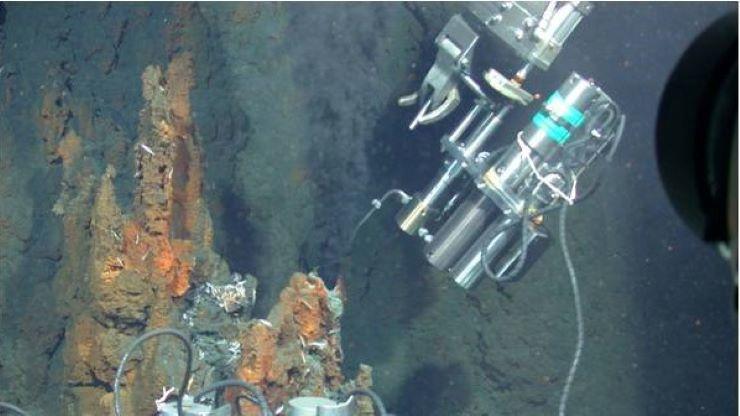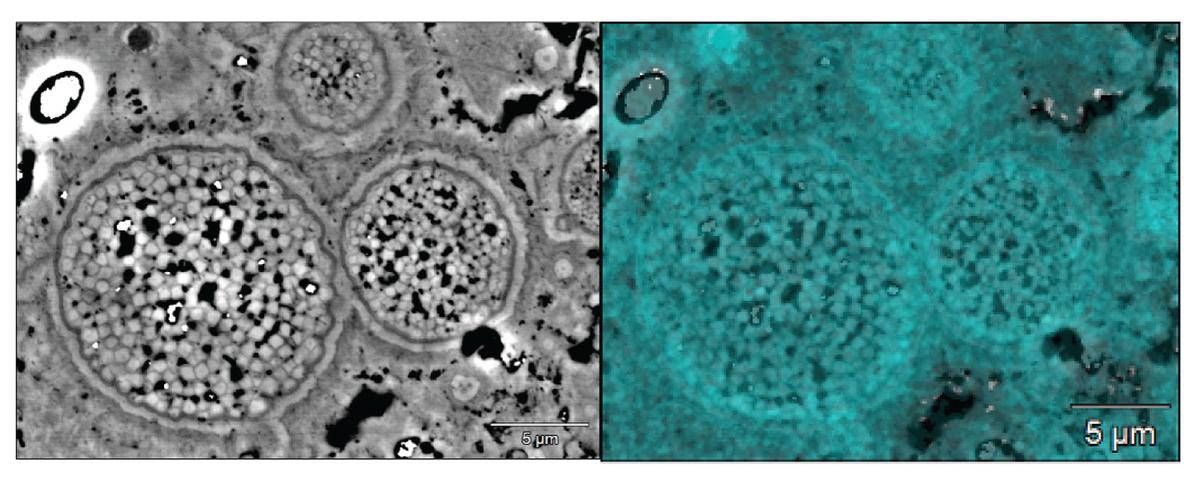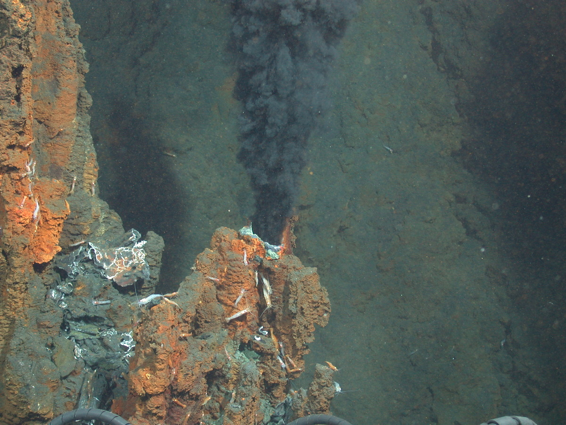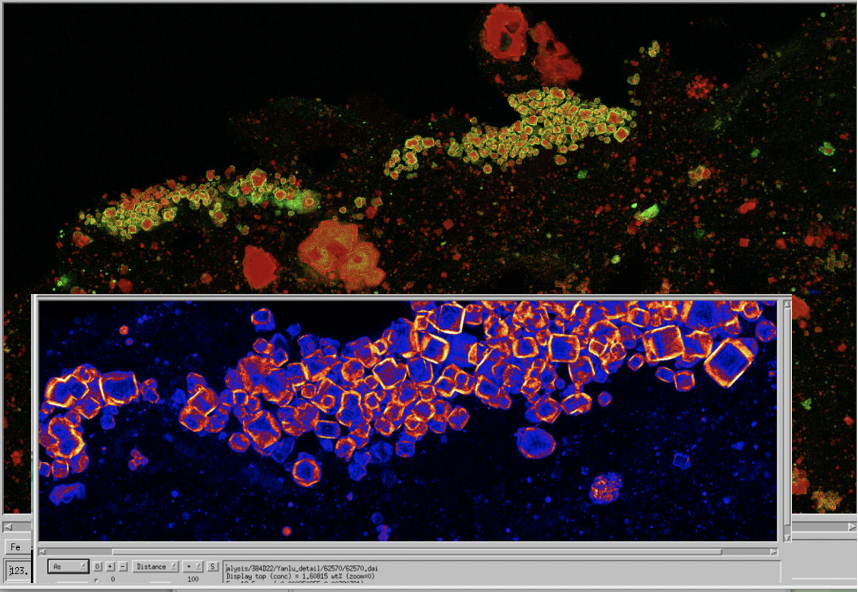Field Studies of Hydrothermal Venting in Submarine and Subaerial Settings
Seafloor hydrothermal systems have played a key role in controlling seawater chemistry in the modern and ancient ocean, while providing chemicals that fuel deep sea hydrothermal vent ecosystems. This research is being carried out in collaboration with a highly diverse group of scientists associated with academic and federal agencies. In addition to direct sampling and analysis of hydrothermal vent fluids, the aqueous geochemistry group has played a key role in the development of novel chemical sensors that can be used to monitor―directly and remotely―pH and redox of fluids issuing from hydrothermal vents on the seafloor.

Yellowstone Lake
Ongoing collaborative research at Yellowstone Lake aims to quantify and explain fluxes of multi-phase fluids and dissolved components through sublacustrine hydrothermal vents in the context of external tectonic, magmatic, and climatic processes. Results also shed light on mineral deposit formation processes and chemical conditions affecting microbial ecosystems at the bottom of the lake.
So far, results have confirmed that sublacustrine vents in the deepest parts of Yellowstone Lake are dominated by discharge of high enthalpy vapors owing to the proximity of magmatic bodies beneath the lake floor. The vapor (steam) subsequently mixes with lake water prior to discharge such that venting fluids achieve temperatures as high as 174 ⁰C, the highest-temperature geothermal phenomenon yet observed in Yellowstone National Park. Gas-rich vapors containing CO2 and H2S acidify and chemically reduce lake waters at the vent fluid/lake water interface. Such reactions, which are a hallmark of hydrothermal activity at Yellowstone generally, lead to large scale dissolution of vent deposits and enhanced microbial metabolism. While data from this project are specific to activity at Yellowstone, implications extend to fluid-mineral systems generally, in both continental and marine settings.
Toxic metals at Yellowstone
Yellowstone Lake is one of the world’s most active volcanic-hydrothermal systems. Several toxic metal elements including As, Hg, Mo and Cu, are enriched in vent water and lake sediments. Minerals such as pyrite, pyrrhotite and clay minerals in lake sediments can buffer these toxic metals in lake water. Understanding the distribution and the oxidation state of these toxic elements in pyrite, pyrrhotite and other hosts in Yellowstone Lake sediments will help to estimate their response to changes of lake chemistry and climate induced changes in lake depth, temperature and pressure, thus having high geological, ecological and environmental significance. In this project, we collected sediment samples from the lake bottom using Remote Operate Vehicle (ROV), down 200m from the lake surface, where the vent fluid temperature goes up to 170 ⁰C. Samples are analyzed using advanced characterization techs including SEM, Electron Microprobe and Synchrotron-based X-ray analysis.

Laboratory Studies of Mineral-Fluid Reactions and Isotope Exchange Processes
The Department of Earth and Environmental Sciences at the University of Minnesota hosts state-of-the-art facilities for conducting process-oriented research on chemical and isotopic exchanges between fluids and minerals. In some cases, studies using these facilities link directly to our field programs described above, but the research represents stand-alone investigations of many fundamental aspects of environmental aqueous geochemistry.
Research topics include:
- Investigations of geochemical controls on abiotic hydrocarbon formation.
- Experimental calibration of the effects of temperature, pressure and chemical composition on the partitioning of non-traditional stable isotopes. Such calibration efforts are necessary if these isotope systems are to fulfill their promise as process oriented tools in aqueous geochemistry.
- Flow-through hydrothermal experiments to investigate the role pH, redox, pressure, and temperature on elemental partitioning between vapor and brine in fluid-mineral systems.
Phase separation and mineral-fluid equilibria in the near-critical region
Recent studies suggest that phase separation in the near-critical region of seawater plays a fundamental role in the chemical evolution of seafloor hydrothermal vent fluids. However, these temperature/pressure conditions represent a “geochemical blind spot” where a lack of experimental and/or theoretical data prevent quantitative interpretations of fluid chemistry.
By using well known and compositionally fixed minerals to buffer fluid chemistry, we can better explore the extent to which pH, redox, and transition metal- and gas solubility effect elemental partitioning between phases. Simultaneously, such studies provide new experimental data on mineral solubility at these critical temperature, pressure, and composition conditions. Ultimately, the aim of this research is to document the effects of homogeneous and heterogeneous (mineral-fluid) reactions on the partitioning of elements between coexisting vapors and liquids at elevated temperatures and pressures.
Trace Element and Isotopic Analyses
A newly installed triple quadrupole inductively coupled mass spectrometer (TQ-ICP-MS) significantly advances current laboratory expertise in hydrothermal experiments to include studies of trace element partitioning and behavior during hydrothermal alteration and mineral deposition. Additional isotopic analyses, likewise achievable by TQ-ICP-MS analysis, facilitate studies of isotopic fractionation, elemental cycling, and reaction rates in natural and experimental systems. A primary component of this new line of research will be developing appropriate techniques to conduct trace element and isotopic analyses of rocks, minerals, natural groundwaters and aqueous fluids, and experimental run products.
Hydrothermal cycling of biologically essential trace elements
A new NASA-funded project investigates cycling of molybdenum and other biologically essential trace elements in the Archean ocean and modern Archean-analog settings. By combining theoretical, experimental, and field sampling approaches we aim to quantify seafloor hydrothermal contributions to global molybdenum and other trace element cycles and identify relevant geochemical processes in modern and ancient settings.


